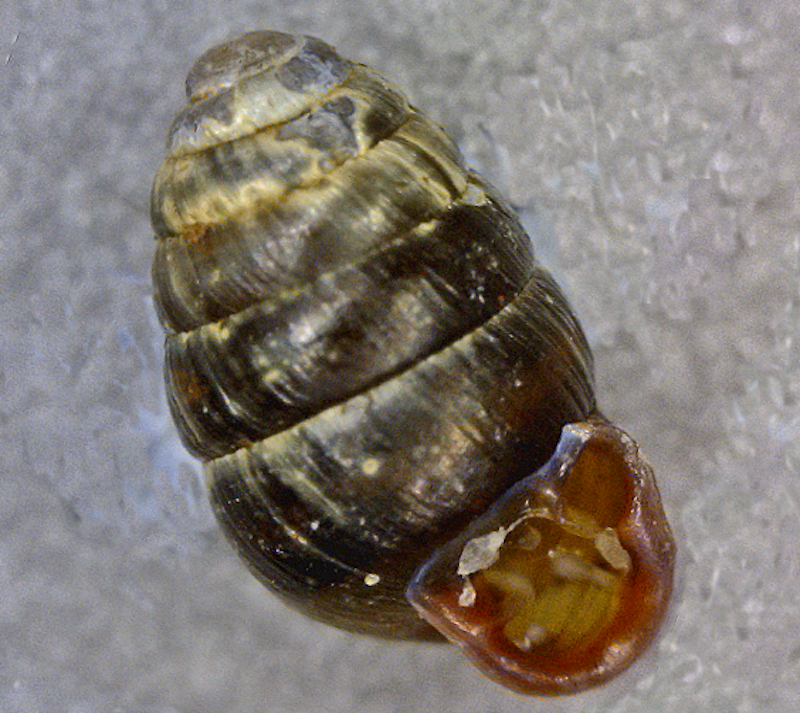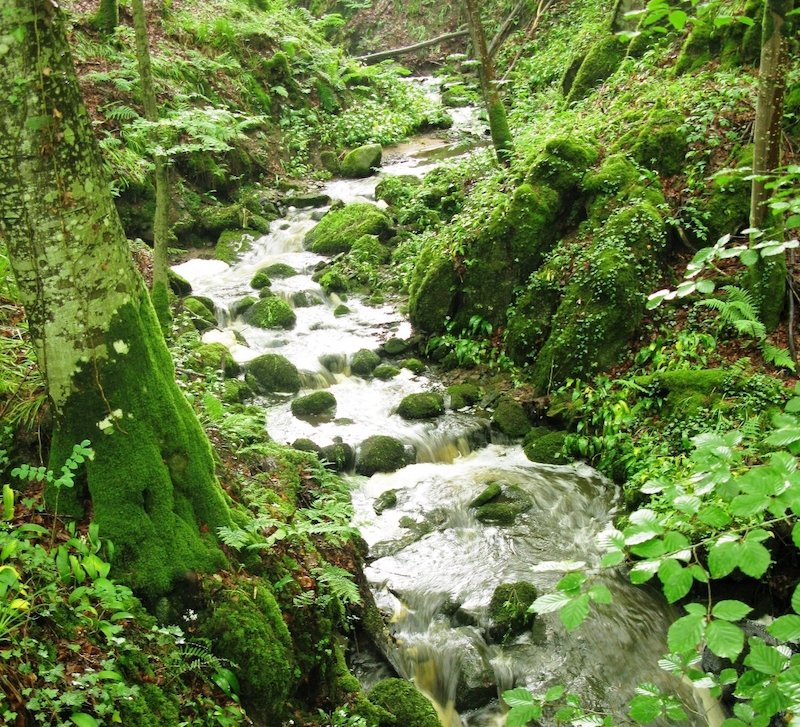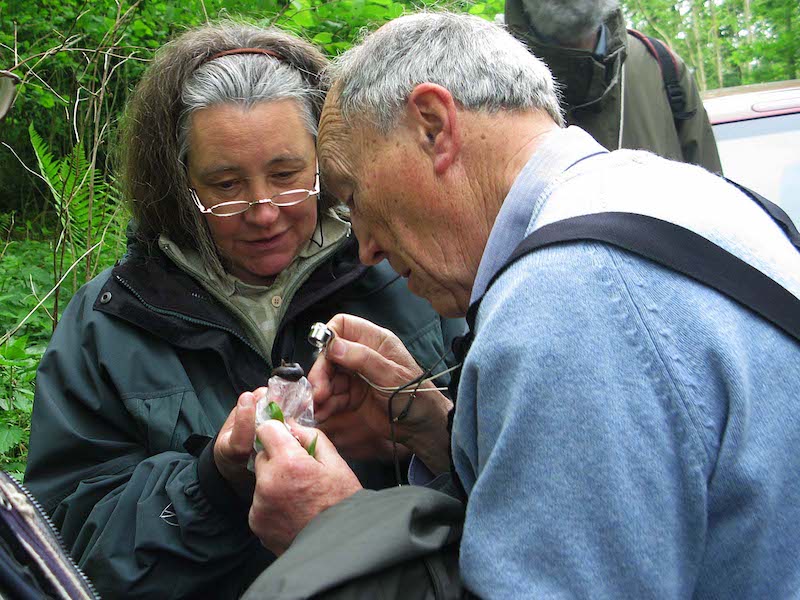|
The suggestion of a Conchological Society field meeting in Dumfries & Galloway had been around for some time, but finally, with encouragement from Mark Pollitt of the Dumfries & Galloway Environmental Record Centre, it happened on a late May weekend. Choosing sites to visit was a major problem, because the area is so under-recorded (Snailing in Dumfries and Galloway, Mollusc World no. 25, March 2011), and there are so many potentially interesting places to go to. Eventually three SSSIs (Sites of Special Scientific Interest) were chosen, notable, so far as the region is concerned, for being on neutral or basic soils. The fourth site was a wooded area on the outskirts of the small town of Langholm. To minimise travelling, but at the same time still covering a wide area, all the sites were in Dumfries-shire.
The first site visited was the Stenhouse Wood SSSI (Grid ref. NX795931; figure 1), which is an upland ash woodland on base-rich soil. Although it had rained overnight, the rain largely held off during the morning, and a group of eight enthusiasts (see back cover), some of whom had travelled hundreds of miles to be there, duly arrived. With so many recorders present, it was easy to split into different groups and tackle different parts of the wood. The damp conditions meant it was easy to find slugs and snails, and we were soon finding a good lot of interesting stuff: ancient woodland species such as Leiostyla anglica (figure 2), Limax cinereoniger and Spermodea lamellata (figure 3) were present in good numbers, and Vertigo substriata was also there. Barry Colville subsequently found Acicula fusca and Punctum pygmaeum, among others, in leaf litter, from this site as well as from the other woods, that he took home with him and subsequently analysed. A. fusca is notable as it is absent from most of Scotland. Stenhouse Wood was not in a pristine condition, however, as we also discovered a specimen of the introduced slug Boettgerilla pallens. Altogether the wood yielded 38 species of molluscs.
In the afternoon we moved a few miles further east (as the crow flies – much further by road along the narrow country lanes) to Chanlockfoot SSSI (NX803990; figure 4), a mixed wood on base–rich soils. Again we divided our forces, but neither end of the wood turned out to be particularly good, and we all finished up in a nice really moist area somewhere in the middle. We were rained off earlier than we should have liked, but not before we had found 34 species. The feeling was that we had probably found most of the interesting species there. The fauna was quite similar to that of Stenhouse Wood, with a good mix of ancient woodland species, but at Chanlockfoot we also found Clausilia bidentata, Columella aspera, Lehmannia marginata and Zenobiella subrufescens, not found in Stenhouse Wood.
The heavy rain continued for most of the night, but fortunately had cleared away by the time we reached Penton Linns SSSI (NY433773; figure 5) near Canonbie, in the east of the county and right on the border with England. The site is designated as a SSSI for geological reasons, being notable for its fossils; however, it was the presence of limestone that attracted us. In fact, most of our observations were probably not in the SSSI, but a little further up the hillside; the overnight rain meant that it would have been too slippery to work nearer the river, the Liddel Water, which was in spate.
We very soon found evidence of the limey nature of the site in the form of Cochlodina lamellata (figure 6), otherwise extremely local in Scotland. The site also turned up many specimens of both Columella species, as well as Ashfordia granulata; most of the species recorded were similar to those found the previous day, though Penton Linns had the record total for the weekend of 39 species of molluscs.
After our picnic lunch, some members of the party with long journeys ahead of them had to leave, but the rest of us visited the small town of Langholm nearby, and investigated a wooded bank rising from the flood plain of the nearby River Esk (NY360852). This was obviously going to be a very different site from those visited earlier, having been subject to centuries of human intervention (but nevertheless worth recording in this seldom–visited area). Ancient woodland species were clearly absent, and species characteristic of more disturbed sites were present; for example, Langholm provided our only record of Deroceras panormitanum, and indeed Stenhouse Wood was the only other site to have Deroceras reticulatum. Altogether, Langholm produced only 21 species, still a respectable total, but nowhere near the richness of the woodland SSSIs visited. Nevertheless, several of the species seem to be new records for the area.
Altogether, the weekend must be regarded as a great success, with 50 species recorded altogether (see list), of which a high proportion were new to their respective areas. This is entirely due to the keen and expert conchologists who were prepared to travel long distances to visit these sites; it seems safe to say that a single recorder would not have found anything like so much. As well as providing a much greater recording effort and expertise, each recorder had specialised skills which resulted in more species being identified and enabled others to learn more about the various species we found. It was especially valuable to be able to discuss specimens with other recorders (figure 8). In addition, our thanks are due to Beth Wilson and Jonathan Warren of the Dumfries office of Scottish Natural Heritage, and Lorna Reeder of the Buccleuch Estates, who did so much to facilitate and encourage our visit. |
figure 1: Stenhouse Wood SSSI. (photo: Rosemary Hill)
figure 2: A specimen of Leiostyla anglica from Stenhouse Wood (height c. 3.5 mm). (photo: Ron Boyce)
figure 3: A crawling specimen of Spermodea lamellata from Stenhouse Wood (width c. 2.0 mm). (photo: Ron Boyce) figure 4: Chanlockfoot SSSI. (photo: Adrian T. Sumner)
figure 5: Penton Linns SSSI. (photo: Rosemary Hill)
figure 6: Cochlodina lamellata, Penton Linns. (photo: Tony Wardhaugh)
figure 7: Rosemary Hill and Barry Colville discuss an interesting specimen. (photo: Ron Boyce) |
| Species | Location | Species | Location |
|---|---|---|---|
| Acanthinula aculeata | S, C, P | Deroceras laeve | C |
| Acicula fusca | S, C, P | Deroceras panormitanum | L |
| Aegopinella nitidula | S, C, P, L | Deroceras reticulatum | S, L |
| Aegopinella pura | S, C, P, L | Discus rotundatus | S, C, P, L |
| Arianta arbustorum | S, C, P, L | Euconulus fulvus | S, C, P |
| Arion ater agg | S, C, P, L | Lauria cylindracea | S, C |
| Arion ater s.s. | S, C, P | Lehmannia marginata | C, P, L |
| Arion circumscriptus s.s. | S, C, P | Leiostyla anglica | S, C, P |
| Arion distinctus | S, C, P, L | Limax cinereoniger | S, C, P |
| Arion intermedius | S, C | Limax maximus | S, P |
| Arion owenii | S, P, L | Nesovitrea hammonis | S, C, P |
| Arion silvaticus s.s | S | Oxychilus alliarius | S, C, P, L |
| Arion subfuscus | S, C, P, L | Oxychilus cellarius | S, C, P, L |
| Ashfordia granulata | P | Oxychilus draparnaudi | P |
| Boettgerilla pallens | S | Perforatella subrufescens | C, P |
| Carychium minimum | S, C, P, L | Pisidium personatum | S, P |
| Carychium tridentatum | S, C, P, L | Punctum pygmaeum | S, P, L |
| Cepaea hortensis | S, C, P, L | Spermodea lamellata | S, C |
| Cepaea nemoralis | S, C, P, L | Succinea putris | L |
| Clausilia bidentata | C, P | Trochulus hispidus | P |
| Cochlicopa lubrica | S, C, P | Trochulus striolatus | S, P |
| Cochlicopa lubricella | S | Vertigo substriata | S, C |
| Cochlodina laminata | P | Vitrea contracta | C, P |
| Columella aspera | C, P | Vitrea crystallina | S, C, P, L |
| Columella edentula | S, P, L | Vitrina pellucida | S, C, P |
S = Stenhouse Wood SSSI, C = Chanlockfoot SSSI, P = Penton Linns, L = Langholm






